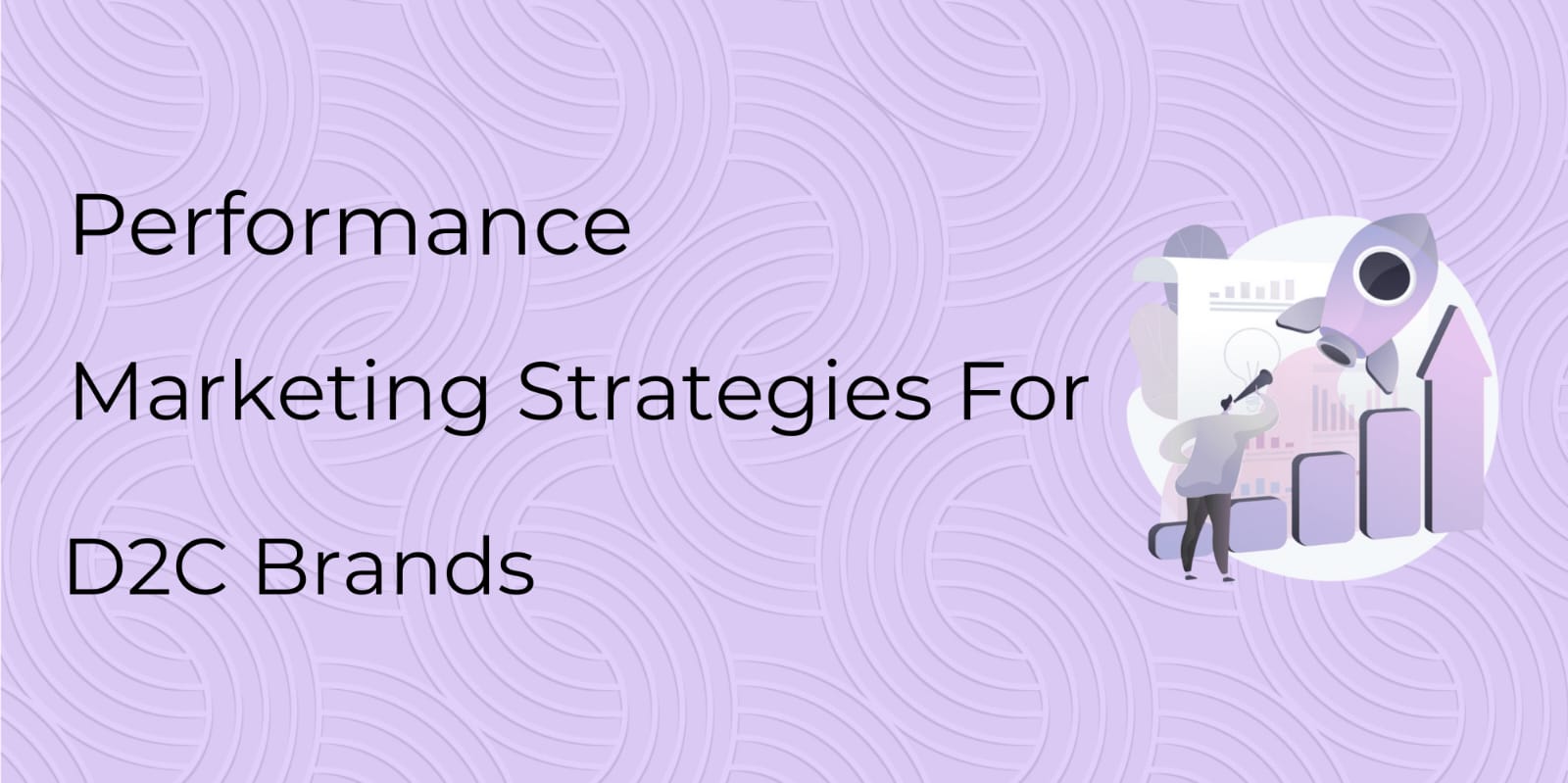Over the last ten years, D2C brands have fundamentally reshaped how consumers discover, consider, and buy any product. Given the explosion of e-commerce and digital marketing tools, it’s simpler than ever before for rising brands to connect customers directly, bypassing traditional methods of product distribution.
But this also means that the competition is fierce and CAC keeps increasing. And that’s where performance marketing becomes a game-changer. Unlike traditional marketing, which usually revolves around either reach or impressions, performance marketing is completely driven by measurable actions: clicks, conversions, sales, and ROAS.
● What is Performance Marketing for D2C Brands?
Performance marketing is a class of digital marketing in which an advertiser pays only when a required action, such as a sale, lead, click, or sign-up, is completed.
This approach provides several added advantages to D2C brands:
- Higher control over spend and attribution
- Real-time optimization
- Precise targeting, based on customer data.
- PEO-led scalable growth based on performance metrics
Performance marketing channels generally include Meta Ads, Google Ads, influencer affiliate programmes, email automation, and retargeting, among others.
- Meta Ads (Facebook & Instagram): Still the King of D2C Acquisition
Even with increasing ad costs, Meta platforms are the most powerful channel for D2C marketing thanks to their deep audience targeting and creative testing capabilities.
Key Strategies for Success on Meta Ads
a. Value-Based Lookalike Audiences (VBLAs)
These audiences are built from your most valuable customers. Instead of just looking at simple purchases, Meta evaluates:
- Average order value (AOV)
- Lifetime value (LTV)
- Frequency and recency of purchases
This increases the chances of getting quality customers instead of one-time buyers.
b. High-Converting Creative Variety
Creative fatigue is the #1 reason campaigns stall. Successful D2C brands rotate creative formats such as:
- UGC videos
- Before-and-after imagery
- Advertisements based on testimonials/reviews
- Product demo videos
Hooks with problem-solution angles
UGC ads, in particular, always tend to outperform branded creatives because of their authenticity.
c. Retargeting the Full Funnel
A performance-driven retargeting funnel would comprise:
- View Content audience: Educate and build trust
- Add to Cart users: Add urgency or provide incentives
- Engagers: Showcase social proof and reviews
A well-structured retargeting strategy usually reduces CAC and increases overall ROAS.
- Google Ads: Capturing High-Intent Shoppers
While Meta is excellent for discovery, Google is strongest for capturing buyers who are ready to purchase.
Top Google Campaign Types for D2C Brands
a. Performance Max (PMax) Campaigns
PMax uses AI to serve ads across all Google properties, including Search, Display, YouTube, Maps, and Gmail.
Best practices:
- Feed the system with high-quality product data
- Upload creative variations – videos and images.
- Employ customer lists for improved signal quality
. Branded Search Campaigns
Even if your brand name is unique, protecting your branded search terms is important for the following: - prevent competitor bidding
- Ensure control over your brand messaging
- capture high-intent traffic at a low cost
b. Shopping Ads – Standard or Smart Shopping
Product visuals, shown directly on Google SERPs, attract users already in buying mode.
Optimisations:
- High-quality product images
- Keyword-rich product titles
- Seasonal promotions and pricing
- Influencer & Affiliate Marketing: Performance-Based Creator Partnerships
Influencers have become an essential partner in the D2C ecosystem, but paying flat fees without tracking the ROI is risky.
Performance-based influencer marketing solves this problem.
How D2C Brands Can Leverage Influencers Efficiently
a. Affiliate Programs with Clear Rewards
Provide influencers with unique coupon codes or affiliate links attached to commissions. This means that influencers are incentivised to drive conversions, not just views.
b. Utilize Micro-Influencers for UGC Content
Micro-influencers have around 10,000 to 100,000 followers and are more likely to be targeted by marketing because they:
- Higher engagement rates
- Lower partnership costs
- More authentic content
You can repurpose their content in your ad campaigns, landing pages, and email flows.
c. Ambassador Communities
Brands such as GymShark and Glossier grew hugely with ambassador programs that encourage
- Posting of regular content
- Peer recommendations
- Grassroots-level brand awareness
- Email & SMS Automation: The Revenue Engine Behind Every D2C Brand
Acquiring customers is only the beginning; retention is where profits really lie.
Automation of email and SMS can drive 30-40% of the total revenue for profitable D2C brands.
Essential Email Flows for D2C Brands
a. Welcome Series
Triggered when users sign up for your newsletter.
Includes:
- Brand story
- Best-selling products
- Social proof
- Discount on first purchase
b. Abandoned Cart Sequence
Recover lost revenue with this must-have, usually comprising 3-5 emails displaying reminders, social proof, and limited-time offers.
c. Post-Purchase Flow
It improves customer satisfaction and increases repeat purchases.
Includes:
- Product usage guides
- Review requests
- Upsell recommendations
d. Winback Flows
Re-engage your inactive subscribers with new product launches or exclusive offers.
- Conversion Rate Optimization (CRO): Lower CAC Without Spending More
Your ads can bring great traffic, but if the website doesn’t convert, you’re burning money.
CRO focuses on improving your website experience so that more visitors convert into customers.
CRO Techniques that D2C Brands Should Implement
a. High-Speed, Mobile-Optimized Website
A slow loading speed increases the bounce rate and decreases sales.
b. Social Proof Throughout the Funnel
Use:
- Reviews
- UGC videos
- Customer photos
- Trust badges
c. Clear, Benefit-Focused Messaging
Within 3 seconds of landing on the page, explain the problem that your product solves.
d. Smart Upsell & Cross-Sell
Tools such as post-purchase upsells can increase AOV by 20–30%.
- Customer Lifetime Value (LTV) Optimization
D2C brands frequently fail because they get so caught up in CAC and aren’t thinking about LTV.
Increasing LTV allows you to spend more on acquiring new customers.
Strategies to Increase LTV
- Subscription programs
- Loyalty programs
- Personalized offers and recommendations
- Packaging inserts containing QR codes
- Bundles and value packs
A higher LTV boosts profitability and gives your brand an edge over competitors.
- Tracking, Analytics & Attribution: The Backbone of Performance Marketing
Without proper tracking, performance marketing becomes guesswork.
Tools to Use:
- Google Analytics 4 (GA4)
- Meta Pixel
- Google Tag Manager
- Third-party attribution tools: Northbeam, Triple Whale
- UTM tracking
I am a diligent, friendly person who takes the responsibilities given to me very seriously.
Metrics That Matter: - CAC – Customer Acquisition Cost
- ROAS: Return on Ad Spend
- MER – Marketing Efficiency Ratio
- AOV: Average Order Value
- LTV: Lifetime Value
Tracking these metrics helps brands optimise budgets and scale efficiently.
- Scaling Strategies for D2C Brands
Once you have found winning campaigns, it’s time to scale.
a. Horizontal Scaling
Testing new:
- Audiences
- Creatives
- Platforms
- Influencers
This reduces dependence on a single campaign.
b. Vertical Scaling
Increase daily budgets on winning campaigns gradually, 10–20% per day.
c. Expansion into New Channels
D2C brands should explore:
- Snapchat Ads
- TikTok Ads
- Pinterest Ads
- Amazon Ads (if applicable)
This can help to further diversify traffic and reduce the overall CAC.
Conclusion: Performance Marketing is the Growth Engine for D2C Brands
Performance marketing provides D2C brands with a data-driven framework for growing predictably and profitably.
By integrating Meta, Google, influencers, email/SMS automation, and conversion optimisation, brands can create a growth engine that works across the customer journey. The brands that win in today’s digital landscape are those that • Focus on creatives • Use data to inform decisions • Put customer experience first • Optimise their LTV • Continuously test and scale winning strategies. Whether you’re an up-and-coming D2C brand or a widely established one, the above techniques will help build up your sustainable and profitable growth model.


